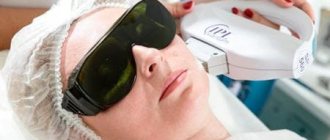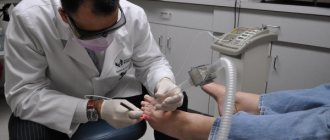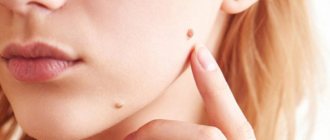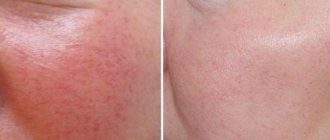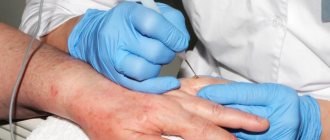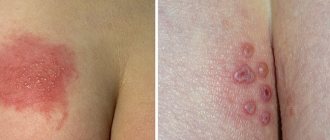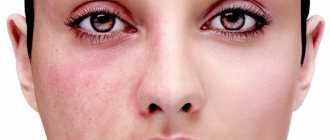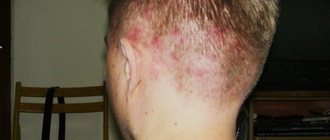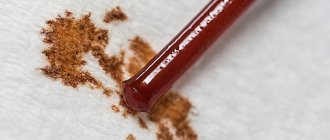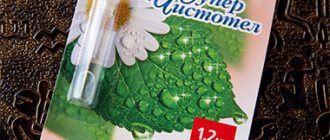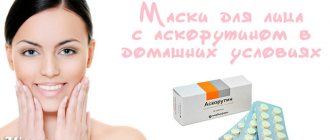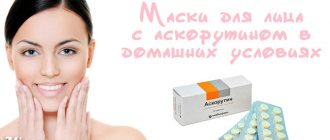There are many ways to help get rid of spider veins on the face. Among all the options, removal of rosacea on the face using laser manipulation is especially popular. During treatment, the laser beam penetrates into the blood vessel, is absorbed by hemoglobin, emits thermal radiation, as a result of which the walls of the capillaries are sealed. The vessel no longer functions, so over time the external manifestations disappear. The advantages include quick results, a short recovery period and a relatively small list of contraindications.
The problem of telangiectasia in cosmetology
For many years, laser treatment of rosacea was not feasible due to the lack of equipment and qualified personnel. To get rid of spider veins and dilations (telangiectasia), electrocoagulation and cryotherapy were used. However, after these effects there was a high risk of scarring and skin deformation.
Modern cosmetology has at its disposal an arsenal of devices that help cope with many external defects. In particular, well-equipped beauty salons offer their clients such a procedure as laser removal of rosacea on the face and other parts of the body.
The problem of combating spider veins occupies an important place in cosmetic angiology. Typically, these capillary expansions are located on the cheeks, nose, and also on the skin of the lower extremities. They are not hazardous to health. However, vascular dilations in the legs are considered a chronic disease and require, in addition to cosmetic procedures and drug treatment. Laser removal of rosacea can also be carried out in this area of the body.
Rehabilitation
The absence of specific contraindications and the relative painlessness of the procedure do not allow you to immediately return to your previous life.
Even if the manipulation is successfully carried out, it is recommended to refrain from the following procedures for some time:
- visiting hot saunas, baths;
- it is necessary to reduce the number of water procedures;
- exclude hardware cosmetology procedures, massages;
- avoid ultraviolet radiation and direct sunlight;
- physical exercise.
When removing large vessels on the face, it is recommended to increase the rehabilitation period to a month to eliminate the risk of rupture of vascular adhesions.
During the entire period, it is necessary to apply a protective cream to the skin before going outside, as well as products that enhance the regenerative and protective properties of the skin.
Why do capillary expansions appear?
There are quite a few reasons for the appearance of rosacea:
- hereditary predisposition;
- liver diseases;
- disturbances in the outflow of venous blood;
- degeneration of subcutaneous adipose tissue;
- changes in the blood coagulation system;
- pregnancy.
External influences increase the manifestations of rosacea. These include:
- exposure to the sun and solarium;
- frequent deep facial peeling;
- frostbite;
- use of hormonal drugs (estrogens, glucocorticoids);
- surgical injuries;
- radiation therapy of malignant tumors.
Vasodilation can be linear, in the form of spiders, spots or tree branches. Treatment of rosacea with laser therapy has revolutionized the care of patients with this condition.
Efficiency
Results are usually visible after the first procedure. In the presence of large vessels or severe rosacea, the effect can be observed after several sessions.
Usually, after completing the entire course of laser therapy, the skin acquires an even and beautiful color. Even if negative effects occur after the procedure in the form of peeling or redness, they disappear on the third day.
Features of the manifestation of rosacea in men
Men usually consult a doctor if rosacea is located on the nose, because others associate such a defect with alcohol abuse.
The disease itself occurs somewhat less frequently in men than in women. In its occurrence, environmental factors are of greater importance - frost, sun, exposure to wind. Another common cause of rosacea in men is liver disease.
Treatment for men is based on the same principles as for women.
Cost of sessions
The final cost is formed from a number of aspects, ranging from the region where the clinic is located, to the professionalism of the doctor and the cost of hardware.
Average cost of laser processing 1 sq. cm of leather varies from 850 to 6000 rubles. This price range depends on the severity of vascular lesions, if it is necessary to treat a large area of skin, or when working with expensive equipment.
The more expensive the equipment, the faster the existing problem is eliminated, and this significantly saves the patient’s budget.
For more details on the procedure and its effectiveness, watch the video.
How does laser work for rosacea?
Selective laser coagulation helps to remove rosacea on the face with laser. This method is based on the ability of different tissues and cells that make up the skin to absorb light rays with different strengths. The laser acts more strongly on some formations, and less intensely on others.
The amount of energy absorbed by the fabric depends on how many special light-absorbing substances it contains. These substances are called chromophores. The main chromophores of the skin are water, melanin (the pigment that colors the skin) and hemoglobin found in red blood cells. However, they absorb laser radiation of different wavelengths. Therefore, to target blood vessels specifically, the laser is adjusted in such a way that its wavelength exactly corresponds to the greatest absorption of radiation by hemoglobin.
Laser radiation with the required wavelength is absorbed by the chromatophores of the skin - the dermis and epidermis, that is, hemoglobin contained in blood cells. In this case, light turns into heat. Thermal energy selectively destroys red blood cells without damaging surrounding tissue. This significantly reduces the risk of scar formation. The vessels become clogged and collapse, and then their lumen becomes overgrown - sclerosed. As a result, they become invisible.
Laser treatment of rosacea using green or yellow wavelengths is very effective. The same method is used to combat nevi, angiomas and hemangiomas, “port-wine stains,” that is, any benign vascular formations.
Pros and cons
In addition to the advantages and disadvantages, the laser vascular reconstruction procedure has some disadvantages:
- undergoing several procedures when affecting large vessels;
- severe peeling in the treated area;
- high cost of procedures if it is necessary to undergo an entire course of several sessions.
The disadvantages are quite objective and do not always occur for all patients. Usually, the beauty of the skin after laser exposure makes you forget about all the possible disadvantages of the procedures.
Types of lasers to combat spider veins
Depending on the physical characteristics of the beam and the equipment used, several types of lasers are suitable for the treatment of telangiectasia.
The neodymium laser is one of the most modern developments. It can be used at any location of the extended capillary network or small venous vessels. The radiation flows in a powerful, uniform flow, which improves the cosmetic effect. The cooling system eliminates skin burns and reduces the pain of the procedure.
The diode laser is excellent for dilated small venous vessels. The effect is often not immediately noticeable. In severe cases, several sessions may be needed.
Advantages
Laser removal of telangiectasia has a number of advantages, which significantly distinguishes this type of correction from other non-invasive techniques (cosmetics, massages, etc.):
- possibility of extended effects on skin structures;
- a thin laser affects only damaged capillaries;
- for minor damage to blood vessels, one procedure is sufficient;
- absence of burns and scarring of the skin;
- no need for anesthesia.
In addition to removing the vascular network, it is possible to improve the overall condition of the skin and launch natural regenerative processes in the deep structures of the skin without surgery.
How is the treatment carried out?
The procedure is usually performed without pain relief. However, in some clinics, numbing cream is applied to the skin of the treated area 30 minutes before the procedure.
The patient lies down in a chair, his skin is cleaned, protective glasses are put on his eyes, and then laser treatment is performed. A tingling or burning sensation may be felt when exposed to radiation. The procedure lasts about 15 minutes. If necessary, it is repeated after some time (four weeks). This is usually enough to eliminate dilated capillaries.
Telangiectasia on the legs is treated a little differently. If they are caused by capillary expansion, the laser coagulation method is also used. In this case, several procedures may be required at intervals of one month. If these are venous formations, the laser will not help. In these cases, the introduction of sclerosants is used - substances that “glue” the vascular walls.
After the procedure, redness occurs, which disappears after 1-2 days. During these days, it is recommended not to wash your face, but to cleanse your skin with a chlorhexidine solution, so as not to introduce infectious agents.
A small crust forms at the site of redness, which cannot be removed independently. In a week - 10 days it will disappear on its own. During this time, it is advisable to apply Bepanten or Panthenol cream to the area exposed to laser radiation several times a day. Complete restoration of the skin after laser treatment occurs only after three months.
After laser treatment, you should not visit the solarium or sunbathe. It is recommended to constantly use cosmetics with UV protection (SPF at least 30).
After removing spider veins, it is advisable to try to find out the reason why they occurred and eliminate it (for example, excessive sun exposure). To prevent relapses, you should not visit baths or saunas too often, or steam your face. It is advisable to include in your diet vitamins C, A and nicotinic acid, which strengthen vascular walls, for example, Ascorutin. It is better to give up large amounts of coffee, alcohol, chocolate, and canned foods.
Do not allow weight loss to occur too quickly while dieting or, conversely, excessive weight gain. A rapid change in the thickness of the fat layer does not give the vessels time to adapt to changing conditions, as a result of which they expand again. Physical exercise outdoors with the use of protective face creams will be useful.
In terms of cosmetic procedures, it is necessary to abandon aggressive manipulations, such as chemical peeling, which damage not only the superficial, but also the deeper layers of the skin. Do not use alcohol-based toners, which dry out the skin. In addition, you should avoid any cosmetics containing honey or menthol. Such components can cause allergic dermatitis, which in a person predisposed to rosacea can cause a relapse of the disease.
To prevent relapse, you can use special creams for the treatment of rosacea. They are sold in pharmacies and beauty salons and are not cheap. The doctor who performed the treatment can recommend them.
Carrying out the procedure
The average duration of laser exposure is 30 minutes. During the procedure, patients feel slight discomfort, a feeling of warmth and burning. If the skin is hypersensitive, discomfort or pain may occur; in this case, experts recommend applying an anesthetic cream to the treated area. During exposure, the patient is in a horizontal, comfortable position, the eyes are reliably protected from the laser with special dark glasses.
When treating problem areas with a laser, light energy glues blood vessels together. Small capillaries disappear instantly, large ones first darken and then become less pronounced. After 2-4 weeks, if necessary, a repeat session is performed.
Contraindications
Treatment of rosacea using laser technology is contraindicated or limited in the following cases:
- oncological diseases;
- severe diabetes mellitus with high blood sugar levels;
- uncontrolled arterial hypertension;
- clinically significant thyrotoxicosis;
- severe heart rhythm disturbances;
- angina pectoris III-IV functional classes;
- chronic circulatory failure of III-IV functional classes;
- blood diseases with impaired coagulation and a tendency to bleed;
- systemic lupus erythematosus and other diffuse connective tissue diseases;
- active tuberculosis;
- severe mental illness;
- any acute conditions and fever;
- skin diseases in the affected area;
- pregnancy, lactation;
- epilepsy;
- tendency to form rough (keloid) scars after skin damage.
Possible complications
Complications often arise due to the high sensitivity of the skin to laser exposure, when the depth of penetration of the beam is violated, or when the procedure technique is not followed.
The main complications include:
- redness of the skin in the treatment area;
- small blisters;
- pigmentation;
- formation of new vessels;
- skin suppuration;
- thrombosis of capillary lumens.
Normally, redness, swelling, puffiness, or blisters will disappear within 1 to 2 days after the procedure. Inflammatory lesions disappear after treatment with Vaseline, and pigmentation after applying whitening creams.
If the unpleasant consequences do not go away after a few days, then this is a reason to consult a doctor. A repeat correction course may be required.
Reviews
Marina, 25 years old “I used a laser to remove defects on the wings of the nose. One session did not help, I had to repeat it. But there are no scars left.”
Vika, 29 years old “Both of my cheeks were completely covered with capillaries, probably due to the fact that I am too fond of tanning. They recommended 6 sessions, but 4 were enough. There was slight swelling after the treatment, but I no longer use concealer and foundation every day. Overall, the result is worth it.”
Alexandra, 30 years old “I had stars removed from my nose two years ago. After the second session, a dark spot appeared, the cosmetologist said to wait until it goes away and only then continue the procedure. The effect in the end is very good, however, I really protected my skin from the sun after treatment! There were no scars left, there were redness and bruises - they disappeared within a week after the session.”
